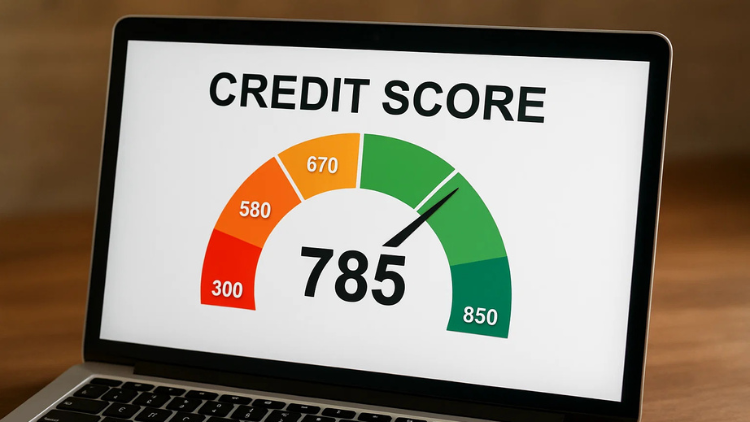Have you ever wondered why one person gets approved for a credit card instantly while another gets denied? Or why your friend qualified for a great mortgage rate, but you were offered something higher?
The answer often comes down to one thing: your credit score.

If you’re just starting out with credit—or if you’ve been told your score isn’t “good enough”—you’re not alone. Credit scores can feel like a mysterious number hanging over your financial life. But here’s the good news: once you understand what goes into your score, you can take clear, simple steps to improve it.
This guide will break down what a credit score really is, what qualifies as “good,” and how you can build and maintain a score that helps you reach your financial goals.
What exactly is a credit score?
Think of your credit score as your financial GPA. Just as a school GPA tells colleges how well you’ve performed academically, a credit score tells lenders how responsibly you’ve managed money in the past.
- Range: Most scores fall between 300 (poor) and 850 (excellent).
- Purpose: Lenders use it to decide whether to approve you for loans or credit cards—and at what interest rate.
- Impact: A higher score can mean lower interest rates, better card offers, and easier approval.
For a deeper dive, Penn State’s SBDC explains the basics of credit and why it’s so important when building your financial future.
Credit score vs. credit report: what’s the difference?
Here’s a common confusion: credit scores and credit reports are not the same.
- Credit Report: A detailed history of your borrowing (loans, cards, payments, etc.). Think of it as your financial transcript.
- Credit Score: A three-digit number based on that report. Think of it as your financial GPA.
You can think of the credit report as the raw data and the credit score as the grade based on that data. To stay informed, you can access your reports for free at AnnualCreditReport, a government-authorized site.
Both are critical, but lenders often look at your score first as a quick snapshot.

How is your credit score calculated?
Your score isn’t random—it’s built from five main factors.
- Payment History (35%)
- Do you pay bills on time? Even one late payment can hurt.
- Credit Utilization (30%)
- How much of your available credit are you using? Experts suggest staying under 30%.
- Length of Credit History (15%)
- Older accounts boost your score. Don’t close your oldest card.
- New Credit (10%)
- Too many applications in a short time can signal risk.
- Credit Mix (10%)
- A variety (cards, auto loan, student loan) helps show you can manage different types.
According to the Consumer Financial Protection Bureau, payment history and credit utilization carry the most weight.
So, what counts as a “good” credit score?
There isn’t a single definition of “good,” but most lenders use similar score ranges. Typically, scores from 670 to 739 are considered good, 740 and above is very good, and 800 or higher is excellent. Anything below 670 is fair or poor and may limit your borrowing options.
Different lenders may define “good” slightly differently, but here’s the general breakdown (based on FICO):
- Poor: 300–579
- Fair: 580–669
- Good: 670–739
- Very Good: 740–799
- Excellent: 800+
For most credit cards and loans, 670 or higher is considered good. But remember, some lenders might want 700+ for the best rewards cards or premium loan rates.
How to build and maintain a good credit score
Here’s where the mystery disappears—building a good score isn’t about tricks. It’s about steady, smart habits:
- Pay bills on time. This is non-negotiable. Even one missed payment can lower your score.
- Keep balances low. If your credit card has a $1,000 limit, try not to carry more than $300.
- Limit applications. Each application adds a small “hard inquiry” to your report. Too many can lower your score.
- Don’t close old accounts. Your oldest card helps your “length of history.”
- Start small if you’re new. Use a secured credit card or a credit-builder loan to prove you can handle credit responsibly.
Your action plan

Ready to take charge? Here’s a simple checklist you can follow to move your score in the right direction.
Each step is practical, clear, and proven to make an impact when applied consistently.
- Check your score. Many banks and apps offer it for free.
- Pay every bill on time. Even if it’s the minimum.
- Aim to keep credit use under 30%. Lower is better.
- Avoid unnecessary applications. Only apply when you truly need credit.
- Use starter tools if needed. A secured card or credit-builder loan can jumpstart your score.
- Be patient. Credit improvement takes months, not days.
Take control of your financial future
Your credit score isn’t a judgment of your worth—it’s just a tool lenders use. The best part? You have control over it. By paying on time, keeping balances low, and being thoughtful about applications, you can move from “fair” to “good” to “excellent.”
A good credit score doesn’t require perfection—it requires consistency. By making smart decisions like paying on time, keeping balances low, and being selective with new applications, you can steadily improve your financial standing.
Remember, every positive action today shapes a stronger, more secure tomorrow. Building credit is not just about numbers—it’s about creating opportunities for your future.
WalletAware shares education, not individualized financial advice. Always confirm current terms on the issuer’s site before applying.